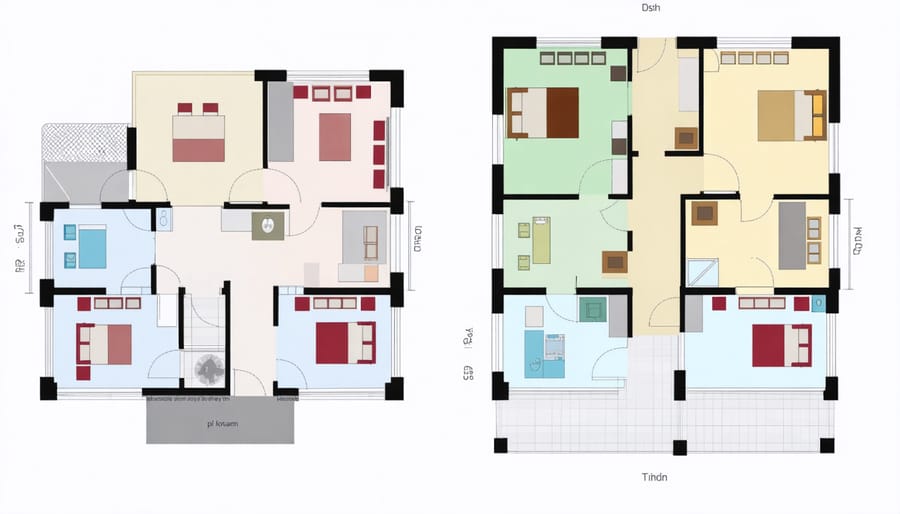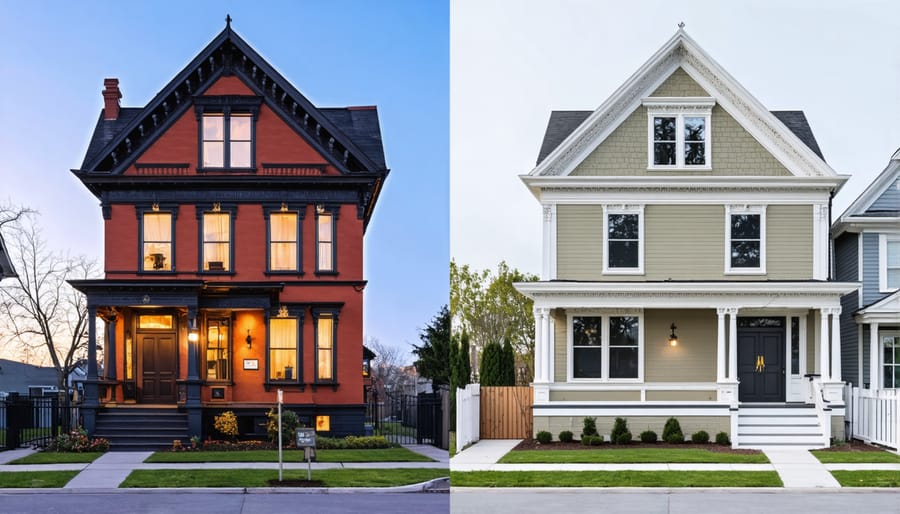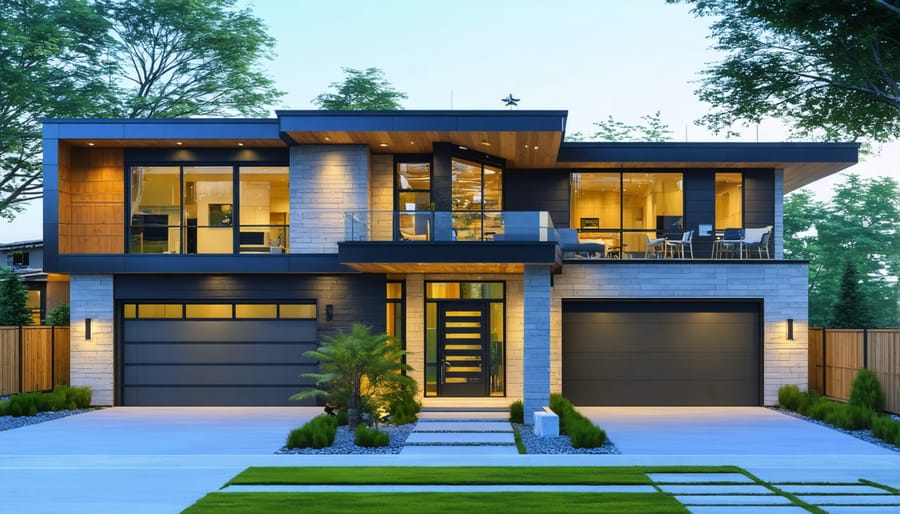Two-family homes represent a perfect blend of practical living and smart investment, offering unique architectural possibilities that cater to modern multi-generational lifestyles. These versatile structures, featuring distinct living spaces for two separate families, have evolved from their humble beginnings as simple side-by-side dwellings to sophisticated architectural statements that define many urban and suburban landscapes.
From classic Victorian-era designs with their characteristic separate entrances and ornate details to contemporary interpretations featuring clean lines and shared outdoor spaces, 2-family homes showcase remarkable architectural diversity. These properties not only provide separate living quarters but also present opportunities for rental income, family proximity, and increased property value in today’s competitive real estate market.
Whether you’re considering purchasing a 2-family home, renovating an existing structure, or simply exploring architectural options, understanding the distinctive features and design principles of these properties is crucial. The thoughtful integration of private spaces, shared facilities, and architectural elements creates homes that balance independence with community, making them increasingly popular among savvy homeowners and investors alike.
Key Features of 2-Family Home Architecture
Common Floor Plans
Two-family homes typically feature two distinct living spaces, each designed to provide comfort and privacy for separate households. The most common floor plan is the stacked arrangement, where one unit occupies the first floor while the second unit takes the second floor, each with its own private entrance. These units often mirror each other in layout, featuring 2-3 bedrooms, a full bathroom, kitchen, and living area.
Another popular configuration is the side-by-side layout, where units share a common wall but spread horizontally rather than vertically. This design often works well for narrow urban lots and provides each family with direct ground-floor access and potentially small private yards.
Some modern 2-family homes incorporate flexible spaces that can serve multiple purposes, such as home offices or playrooms. Smart space-saving solutions, like combined kitchen-dining areas and efficient storage solutions, help maximize the available square footage in each unit. Many designs also include shared spaces like laundry rooms or storage areas in basements, while maintaining separate utilities and HVAC systems for independent living.

Exterior Design Elements
Two-family homes typically showcase distinctive exterior features that blend functionality with curb appeal. The most common design element is the symmetrical facade, often featuring matching entry doors and windows on both levels. These homes frequently incorporate covered porches or stoops for each unit, providing separate outdoor spaces for both families.
The exterior often displays a mix of building materials, such as brick or stone on the lower level with vinyl or wood siding above, creating visual interest while maintaining a cohesive look. Large windows are strategically placed to maximize natural light for both units, usually following a balanced pattern across the facade.
Architectural details might include decorative trim work, cornices, or modest ornamental elements that add character without being overly elaborate. Many two-family homes feature separate staircases, either both at the front or one at the front and another at the side, ensuring privacy for both households.
Rooflines are typically simple and practical, often featuring a gable or hip roof design that accommodates both living spaces efficiently while providing adequate drainage and weather protection.

Popular 2-Family Home Styles
Traditional Styles
When exploring traditional architectural styles for 2-family homes, Victorian and Colonial designs stand out as enduring favorites. Victorian-style duplexes often feature ornate details like decorative trim, wraparound porches, and steep, pitched roofs. These homes typically showcase distinctive elements such as bay windows, intricate woodwork, and multiple paint colors that highlight architectural details.
Colonial-style 2-family homes embrace symmetry and classical proportions, with separate entrances often positioned side by side. These designs commonly include brick or clapboard siding, multi-pane windows arranged in perfect alignment, and simple yet elegant cornices. The layout usually features matching floor plans for both units, with formal living spaces in the front and private areas toward the rear.
Both styles accommodate modern living while maintaining their historical charm. Victorian 2-family homes often incorporate turrets or towers that can serve as unique bonus rooms, while Colonial designs offer practical, well-proportioned spaces that easily adapt to contemporary needs. Many of these traditional homes feature separate back porches or rear entrances, providing privacy for both families while maintaining the building’s architectural integrity.
These classic designs continue to appeal to homeowners who appreciate historical character combined with the practical benefits of multi-family living. Their time-tested layouts and durable construction methods make them excellent candidates for renovation and modern updates while preserving their distinctive character.
Contemporary Designs
Today’s modern architectural features have revolutionized how we approach 2-family home designs. Contemporary layouts emphasize open floor plans, sustainable materials, and flexible living spaces that cater to multiple generations while maintaining privacy.
Popular features include shared outdoor spaces with separate entry points, multi-functional rooms that adapt to changing needs, and energy-efficient designs incorporating solar panels and smart home technology. Many new 2-family homes showcase floor-to-ceiling windows, bringing natural light to both units while creating a seamless indoor-outdoor connection.
Following current design trends, architects are incorporating mixed materials like steel, glass, and sustainable wood to create visually striking facades. Sound isolation technology and thoughtful space planning ensure privacy between units without compromising the aesthetic appeal.
Modern 2-family homes often feature shared amenities like rooftop gardens, fitness areas, or entertainment spaces that foster community while maintaining individual living spaces. Smart storage solutions and built-in functionality help maximize living space in urban settings where square footage comes at a premium.
Innovative designs now emphasize accessibility features, making these homes suitable for aging in place while accommodating younger families, creating truly multi-generational living spaces that work for everyone.

Practical Design Considerations
Privacy Solutions
Privacy is a top priority in 2-family homes, and thoughtful design elements can help create comfortable, separate living spaces for both units. Sound-dampening walls with proper insulation and staggered stud construction significantly reduce noise transfer between units. Strategic window placement prevents direct sight lines between living areas, while frosted glass options add natural light without compromising privacy.
Separate entrances, typically positioned on different sides of the building, allow residents to come and go without crossing paths. Privacy fencing or strategically placed landscaping can create distinct outdoor spaces for each unit. Many modern designs incorporate sound-buffering mudrooms or foyers that act as transition zones between shared and private areas.
Smart floor plan layouts often position bedrooms and private living spaces away from shared walls. Some designs feature offset floor plans where main living areas don’t directly align between units. Additional privacy solutions include separate HVAC systems, individual utility meters, and dedicated storage areas for each unit, ensuring both families can maintain their independence while sharing the same building structure.
Shared Spaces
Designing shared spaces in a 2-family home requires thoughtful planning to ensure comfort and functionality for all residents. The main entrance area often serves as the first shared space, and a well-designed foyer can include individual storage solutions for each family while maintaining an inviting atmosphere.
Common hallways should be wide enough to accommodate foot traffic and feature adequate lighting, with motion sensors being an energy-efficient choice. Consider installing separate mailboxes and intercoms near the main entrance for convenience and privacy.
Outdoor shared spaces deserve special attention too. A shared porch or deck can be divided into distinct seating areas, while a common garden might feature separate plots for each family. For homes with shared laundry facilities, creating a well-organized space with designated storage and scheduling systems helps prevent conflicts.
Parking areas should be clearly marked, with enough space for both families’ vehicles and guest parking when possible. If you’re including a shared yard, consider installing pathways that provide clear access to both units while maintaining some privacy for ground-floor residents.
Remember to incorporate sound-dampening materials in shared walls and flooring to minimize noise transfer between units. Adding separate utility meters for each unit can help prevent disagreements about usage and costs.
Storage and Utility Planning
In a 2-family home, smart storage planning is essential for maintaining harmony between both households. Consider designating separate utility spaces for each family unit, including dedicated laundry areas and mechanical rooms. Built-in storage solutions, such as under-stair closets and mudroom cabinets, maximize every square foot while keeping personal items organized and accessible.
For shared spaces, implement clearly labeled storage systems and consider installing separate locked storage units in common areas like basements or garages. Weather-resistant outdoor storage sheds can provide additional space for seasonal items, gardening tools, and recreational equipment without compromising indoor living areas.
Smart utility planning involves creating separate mechanical systems when possible, including individual water heaters, HVAC units, and electrical panels. This arrangement not only provides independence but also simplifies utility billing and maintenance responsibilities.
Don’t overlook vertical storage opportunities – wall-mounted shelving systems and overhead garage storage can dramatically increase available space. Consider incorporating pull-out pantries, built-in closet organizers, and multi-functional furniture pieces to maximize storage efficiency in each unit.
Remember to plan for adequate trash and recycling storage areas that are easily accessible but tucked away from main living spaces. This thoughtful approach to storage and utility planning ensures both families can live comfortably while maintaining their privacy and organization.
Design Tips for Maximum Value
Curb Appeal Enhancement
Enhancing your 2-family home’s curb appeal not only creates a welcoming atmosphere but also increases property value for both units. Start with the basics by maintaining a well-manicured lawn and adding strategic landscaping elements like flowering shrubs or decorative trees that frame the structure.
Consider updating the exterior paint scheme to highlight architectural details while maintaining visual harmony between both units. Choose complementary colors that reflect the home’s character and neighborhood aesthetic. Adding architectural elements like window boxes, shutters, or decorative trim can create visual interest without overwhelming the facade.
Lighting plays a crucial role in curb appeal. Install matching porch lights and pathway illumination to create an inviting entrance for both units. Consider adding address numbers with a modern design that’s easily visible from the street.
Focus on creating distinct yet coordinated entryways for each unit. Use matching front doors in different but complementary colors, and add potted plants or small garden features to define each space. Don’t forget practical elements like updated mailboxes and hardware that match the home’s style.
For maximum impact, ensure walkways and driveways are well-maintained and consider adding border plantings or decorative pavers. Remember, symmetry is particularly important in 2-family homes – any improvements should maintain balance while allowing each unit to retain its individual character.
Interior Upgrades
When upgrading the interior of a 2-family home, focus on improvements that benefit both units while maintaining separate living spaces. Start with the entryway areas, where durable flooring materials like luxury vinyl or ceramic tile can withstand increased foot traffic while adding visual appeal. Installing separate climate control systems allows tenants to manage their comfort independently and can significantly reduce energy costs.
Consider upgrading shared spaces like laundry rooms with energy-efficient appliances and built-in storage solutions. Adding sound-dampening insulation between units and installing solid-core doors helps ensure privacy and comfort for all residents. Modern lighting fixtures with LED bulbs in common areas can reduce electricity costs while creating a welcoming atmosphere.
In individual units, focus on timeless features that appeal to various tenants. Updated kitchen cabinets with soft-close hardware, quartz or granite countertops, and stainless steel appliances add lasting value. Bathroom renovations should include water-efficient fixtures, modern vanities, and easy-to-maintain tile work.
Smart home features, such as programmable thermostats and keyless entry systems, can be excellent additions that attract quality tenants. Don’t forget about storage solutions – built-in closet systems and pantry organizers make both units more functional and appealing. Remember to maintain a cohesive design aesthetic throughout both units while allowing for some customization to suit different tenant preferences.
Two-family homes represent a versatile and valuable housing option that combines architectural charm with practical living solutions. Throughout this guide, we’ve explored various architectural styles that can transform these dwellings into stunning spaces that serve multiple families while maintaining individual privacy and comfort.
Remember that successful 2-family home design hinges on thoughtful space planning, clear boundary definition, and attention to both aesthetic and functional details. Whether you’re drawn to the classic appeal of Colonial-style homes, the efficiency of modern designs, or the character of Victorian architecture, there’s a 2-family home style that can meet your needs while providing potential rental income.
When planning your 2-family home project, consider factors like separate entrances, sound insulation, and distinct outdoor spaces to ensure harmonious living arrangements. Don’t forget to check local zoning laws and building codes before making any major design decisions or renovations.
For the best results, work with experienced architects and contractors who understand the unique challenges and opportunities of 2-family home design. Regular maintenance and strategic upgrades will help preserve your investment and enhance the living experience for all residents.
By choosing the right architectural style and implementing smart design features, you can create a 2-family home that offers both beauty and functionality while building long-term value for years to come.
